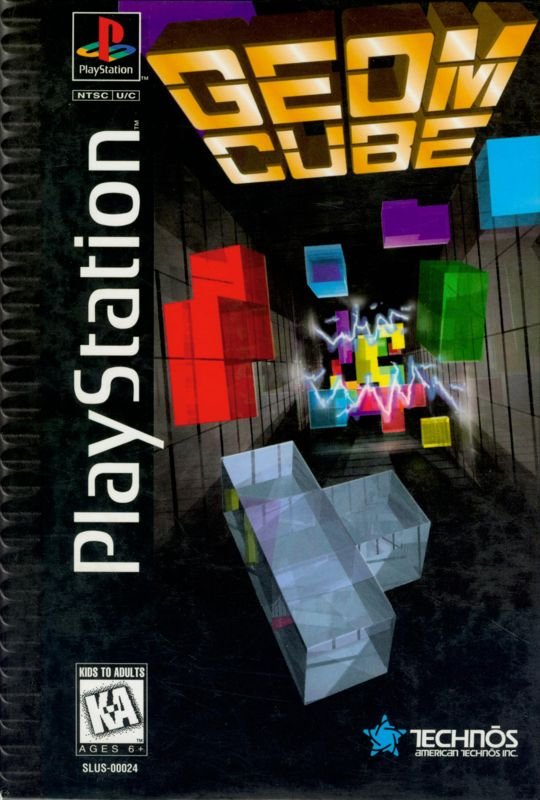Geom Cube on PS1: The Underrated Puzzle Game That Challenged Tetris on PlayStation
In the early days of the PlayStation, a unique puzzle game emerged. Geom Cube, developed by Magifact and published by Sony in 1995, introduced a 3D twist to Tetris. This twist added a new layer of challenge to the game.
Think of Tetris turned on its side, with a new depth. This innovative gameplay mechanic made Geom Cube stand out. It was a hit among puzzle fans, even if it didn’t become widely known.

The game’s simple design and precise controls made it even more appealing. For those seeking a new puzzle challenge, Geom Cube is a must-try. It offers a unique and engaging experience.
Key Takeaways
- Geom Cube is a 3D puzzle game that challenges traditional Tetris gameplay.
- Developed by Magifact and published by Sony Computer Entertainment in 1995.
- The game features a unique spatial challenge with 3D blocks.
- Minimalist design and sharp controls enhance gameplay.
- A hidden gem in the PlayStation puzzle genre, appealing to fans of challenging puzzle games.
The Origins of Geom Cube PlayStation
Geom Cube was released in 1995 by Magifact and published by Sony. It showed off the PlayStation’s power and added to the puzzle game variety. This game was a big hit among puzzle game fans.
Development by Magifact in Japan
Magifact, a Japanese developer, created Geom Cube. They mixed 3D puzzle elements in a unique way. Their goal was to make a game that was both challenging and fun.
Sony’s Publication and 1995 Release Strategy
Sony Computer Entertainment published Geom Cube in 1995. They used the PlayStation’s growing fame to their advantage. Geom Cube was marketed as a top puzzle game for the console.
| Aspect | Details |
|---|---|
| Developer | Magifact (Japan) |
| Publisher | Sony Computer Entertainment |
| Release Year | 1995 |
| Notable Features | 3D puzzle gameplay, innovative design |

Gameplay Mechanics: Beyond Traditional Puzzlers
Geom Cube’s gameplay is unique compared to other puzzle games on the PlayStation. It combines 3D spatial puzzles with block manipulation. This mix challenges players in ways other games don’t.
3D Spatial Puzzle Dynamics
The 3D puzzle dynamics in Geom Cube make it stand out. Players face a complex field that demands careful planning and action.
Block Types and Shapes
Geom Cube has different geometric blocks to manipulate. These blocks vary in shape and size, making the game more complex.
The Cube Playing Field
The game is set in a cube-shaped field. Players must fit blocks together perfectly. The 3D environment requires thinking in multiple dimensions.

Control Scheme and Block Manipulation
The control scheme in Geom Cube allows for precise block manipulation. Players can rotate blocks in three dimensions, which is key to the game.
Rotation in Three Dimensions
Geom Cube’s 3D puzzle rotation system is a highlight. Players rotate blocks to fit them into spaces, needing to understand spatial relationships.
Speed and Precision Challenges
As the game goes on, blocks fall faster. This speeds up the game, requiring quick and precise decisions. This mix of speed and precision makes Geom Cube engaging and challenging.
Scoring System and Objectives
The scoring system rewards players for clearing lines and combos. The goal is to clear as many lines as possible to move up levels.
Line Clearing and Combos
Players get points for clearing lines and combos increase the score. This system motivates players to plan their moves for a higher score.
Level Progression
Clearing lines moves players through levels, each with new challenges. The level system keeps the game exciting and demanding.
Visual and Audio Design
Geom Cube’s visuals and sounds worked together to make a great puzzle game. This teamwork made the game more fun to play.
Minimalist Aesthetic Approach
Geom Cube had a minimalist design. It was simple and focused on solving puzzles. This design kept players focused on the game.
Color Scheme and Block Design
The game’s color scheme was simple and clean. The blocks were easy to see and use. This helped players solve puzzles better.

The game’s interface was easy to use. It was free from clutter. This made it simple for players to understand and play through levels.
Sound Design and Music
The sound in Geom Cube was key to its fun gameplay. The sounds and music together made the game feel real.
Audio Cues and Feedback
Audio cues gave players instant feedback. Sounds like blocks moving or lines clearing helped players feel connected to the game.
Background Soundtrack
The background music was soft but catchy. It added to the game’s feel without getting in the way. It made the game more fun and real.
Difficulty Progression and Learning Curve
The Geom Cube experience is all about getting better as you play. It’s a puzzle game on the PS1 that tests your spatial skills and strategy.
Early Stages and Accessibility
Geom Cube starts off easy for beginners. It teaches the basics in a simple way. The first levels help you learn how to move and rotate blocks.
This makes it easy to start and build a strong base. Then, you can tackle harder challenges.
Advanced Challenges and Spatial Logic
As you get better, Geom Cube gets tougher. It adds new blocks, obstacles, and time limits. You need to think hard and plan ahead.
It’s all about solving 3D puzzles. This tests your ability to see and move objects in space. It’s a real brain workout.
Mastering Geom Cube’s Complexity
Getting good at Geom Cube takes time and practice. You’ll need to really understand how the game works. It’s rewarding to beat tough levels and get better.
This feeling of success keeps you going. It makes you want to keep playing and improving.
| Skill Level | Challenge Type | Required Strategy |
|---|---|---|
| Beginner | Basic Block Manipulation | Understand rotation and placement |
| Intermediate | Increased Block Complexity | Develop spatial reasoning and planning |
| Advanced | Time Pressured Levels | Improve speed and accuracy under pressure |
Geom Cube vs. Tetris: The 3D Evolution
Geom Cube and Tetris were both big in puzzle games, but they were different. Geom Cube was a 3D game on the PlayStation. This shows how these two games were similar yet different.
Comparing Core Mechanics
Both Geom Cube and Tetris are about clearing lines with blocks. But Geom Cube added a 3D twist. This made players think in three dimensions, not just two.
Geom Cube’s controls were more complex. Players had to move blocks in 3D space. Tetris, on the other hand, was simpler to play.
- Key differences:
- 2D vs. 3D gameplay
- Complexity in block manipulation
- Spatial reasoning requirements
Why Geom Cube Remained in Tetris’s Shadow
Geom Cube was innovative but didn’t get as popular as Tetris. It was released in 1995, when 3D games were new. Tetris was already a big hit, known for its simplicity.
Geom Cube’s 3D gameplay might have scared off some players. They were used to Tetris’s easy-to-play style.
Unique Selling Points of Geom Cube
Geom Cube stood out with its 3D puzzles. It was one of the first 3D Tetris games on a console. This made it special on the PlayStation.
- Innovative 3D gameplay
- Enhanced spatial reasoning challenges
- A fresh alternative to traditional 2D puzzle games
Geom Cube is a key part of puzzle game history. It offered a unique experience that, though not as famous as Tetris, helped puzzle games grow.
Conclusion: A Hidden Gem Worth Rediscovering
Geom Cube on PS1 is a standout in the PlayStation puzzle world. It’s not as well-known, but it has a loyal fan base. Its unique gameplay and minimalist design make it a gem waiting to be found again.
The game’s 3D puzzles and retro logic are a big draw for those looking for a challenge. For fans of hidden gems on PS1, Geom Cube is a must-play. It’s a key part of the PS1 puzzle legacy.
Many gamers remember Geom Cube fondly for its tough levels and scoring system. A review of Geom Cube would focus on its control and block manipulation. These features are what make it special.
Geom Cube’s appeal as a retro logic puzzle game is timeless. It reminds us of the innovative puzzle games on PlayStation. It’s a great experience for both old and new gamers.
FAQ
What is Geom Cube, and when was it released?
Geom Cube is a puzzle game by Magifact and Sony Computer Entertainment. It came out in 1995 for the original PlayStation.
How does Geom Cube differ from traditional Tetris?
Geom Cube adds a 3D twist to Tetris. Players must think about depth as well as horizontal moves. It brings a new spin to classic puzzle games.
What kind of gameplay mechanics does Geom Cube feature?
It has 3D puzzle dynamics and a special way to control blocks. There’s also a scoring system for clearing lines and getting combos.
What is the visual and audio design of Geom Cube like?
It has a simple look with basic colors and shapes. The sound and music are designed to make the game more enjoyable.
How challenging is Geom Cube, and what is its learning curve?
It starts easy but gets harder. Players need to use spatial logic to beat the game. It’s a game that gets better with time and effort.
Why did Geom Cube remain less popular than Tetris?
It was released when there were many games out. Its unique features, though challenging, might not have appealed to everyone.
What are the unique selling points of Geom Cube?
Its 3D puzzle play, simple design, and increasing difficulty make it stand out. It’s a notable game in the PlayStation puzzle genre.
Is Geom Cube worth playing or revisiting?
Yes, it’s a hidden gem. Its unique gameplay, challenging levels, and simple design make it a great find for retro gaming fans.
Can Geom Cube be considered a classic puzzle game?
Yes, it’s a classic. Its 3D innovation, engaging gameplay, and challenge make it a memorable game in the puzzle genre.



